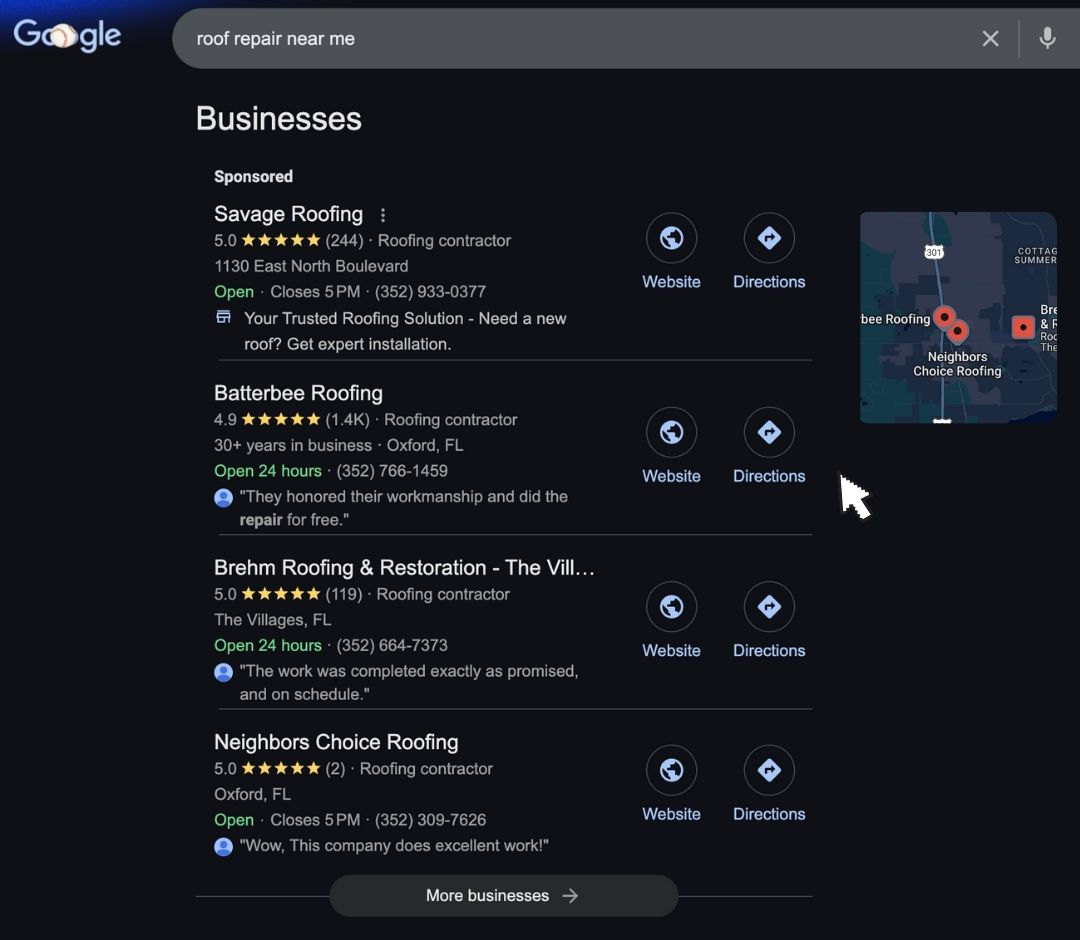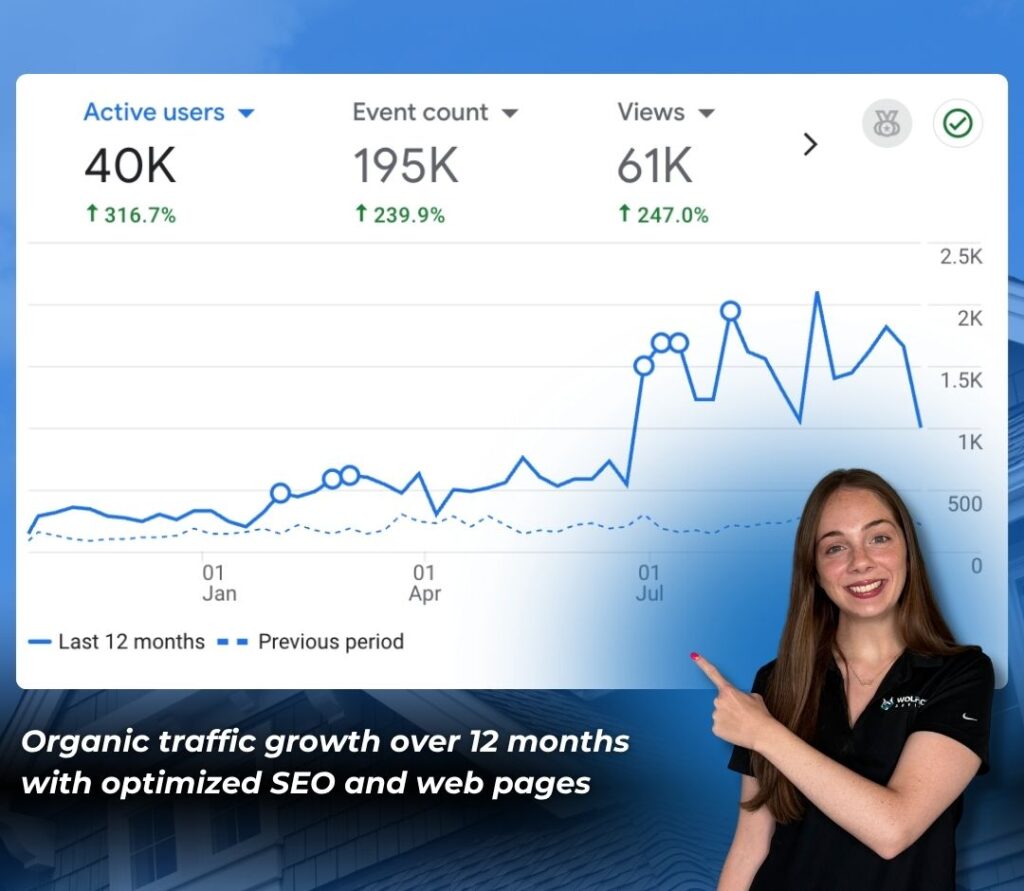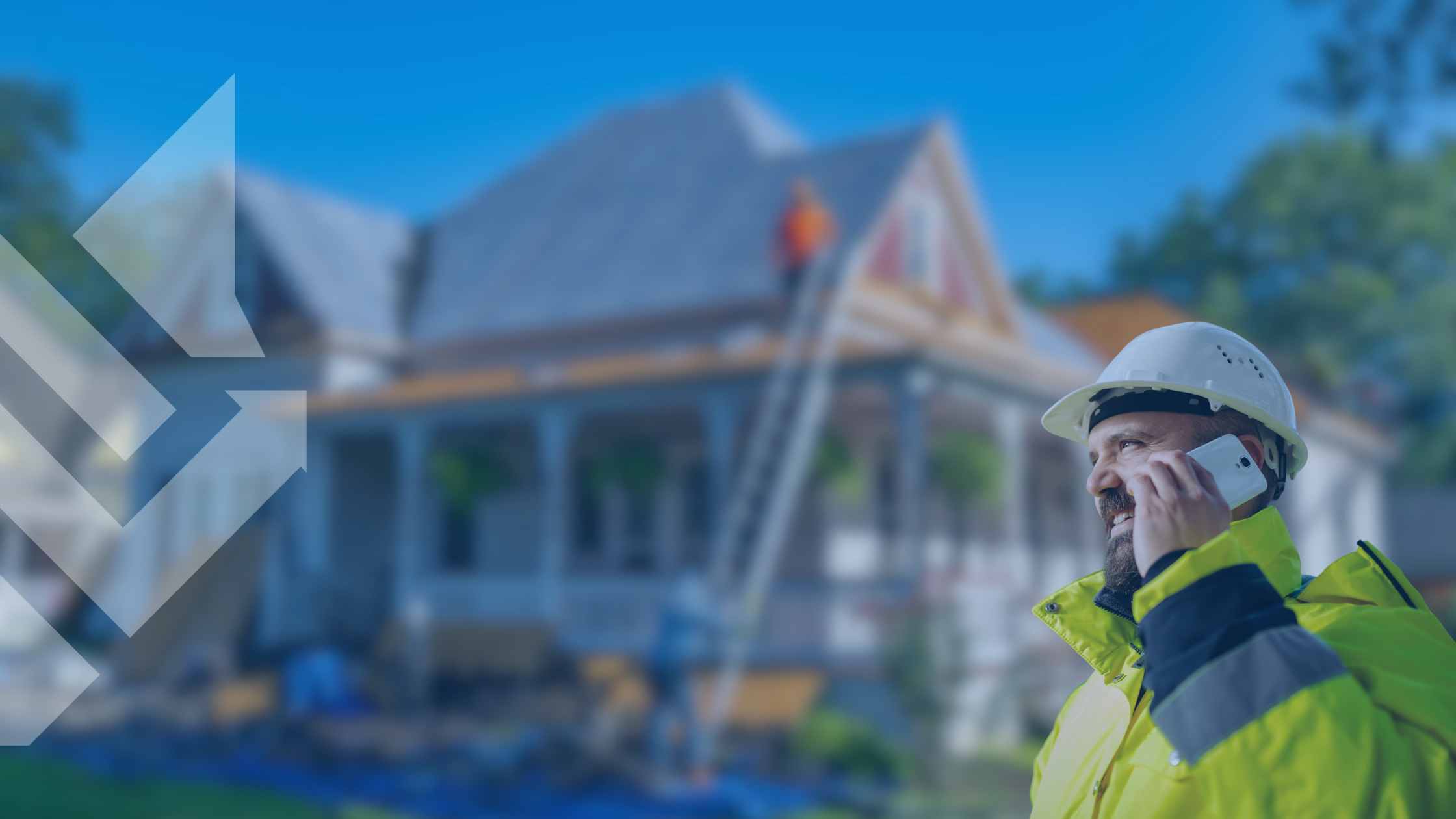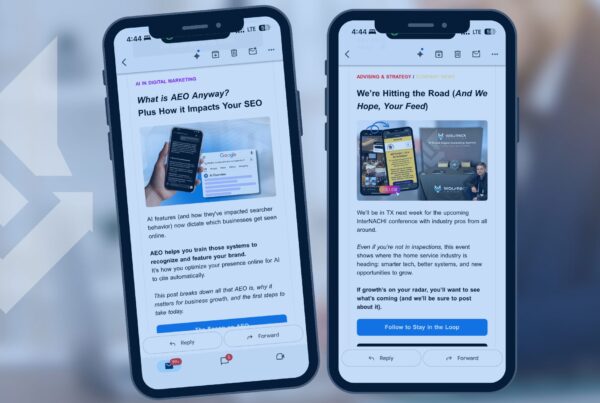In this guide, you’ll learn what roofing SEO entails, how to nail it in an AI world, how Google decides which contractors to rank first, and what specific steps you can take today.
If you run a roofing or contracting business, you already know how fast competition is growing. Every homeowner who types in a relevant question is comparing several companies in seconds. If your business doesn’t appear in those top results, you’re invisible.
Your SEO is what helps your roofing business show up and stand out when they’re ready to call. Here are the CliffsNotes.
Contents
What Does SEO Entail for Roofers Today?
Roofing SEO means making your online presence so strong that homeowners in your area find you first and feel confident enough to reach out.
In the not-so-distant past, SEO focused on stuffing keywords into pages and building random backlinks. Now, Google and other search engines weigh your real-world reputation, customer reviews, site usability, and local authority.
When it comes to the home-services category, almost 9 out of 10 consumers read online reviews for local businesses, making your reputation just as crucial as your reach.
Modern SEO for roofing should focus on:
- Keywords that match homeowner intent (not random terms)
- A site that converts visitors into calls
- Trust signals like reviews, credentials, and consistent contact info
- Technical performance that makes your website fast and mobile-friendly
How Search Engines Decide Which Businesses Show Up
When someone searches for a local roofer, search engines scan hundreds of signals. The main ones are simple.

1. Relevance
Does your content match the searcher’s intent? If someone types “metal roof installation Houston,” your site should clearly state that you provide metal roofing services in Houston.
2. Proximity
How close are you to the searcher, or do you clearly serve their area? Listing accurate service zones on your website and Google Business Profile helps Google know exactly where to show you.
3. Reputation
Do people trust your business? Reviews, ratings, and mentions across other sites all influence how high you appear.
4. Website Quality
Google’s research shows that sites loading within three seconds retain users up to 40% more often. Speed and mobile usability are now ranking essentials.
5. E-E-A-T
Your Experience, Expertise, Authoritativeness, Trustworthiness.
Show your experience through project photos, licenses, testimonials, and educational content. The more you prove your authority, the more search engines reward you.
All of these factors work together to determine whether you appear in the “map pack,” organic listings, or not at all.
Step-by-Step Roofing SEO Plan
This step-by-step system covers everything from choosing the right keywords to tracking real results.
1. Find Keywords That Match the Jobs You Want
| Search Type | Example Keyword | Searcher’s Goal |
| Transactional | “roof repair Charleston SC” | Looking to hire |
| Informational | “how to fix roof leak before rain” | Researching problem |
| Local/Branded | “Charleston roofing contractors” | Comparing companies |
Start by thinking about what services you most want to promote. Every strong roofing SEO plan starts with understanding search intent (what the person is actually trying to do when they search).
Transactional keywords show buying intent. These are best used on landing pages or service pages because the person is ready to call or request a quote.
Informational keywords show learning intent. These belong in blog posts or FAQs, where you can educate the reader and guide them toward your services naturally.
Focus on transactional and local keywords first to attract ready-to-hire customers, but don’t overlook informational keywords that build long-term authority.
Tools like Google Keyword Planner or Semrush can help you find both types of phrases: the ones that drive quick leads and the ones that strengthen your credibility over time.
Also, think seasonally! After a major storm, searches for “emergency roof tarping” or “storm damage repair” can spike (perfect topics for quick blog updates or even social posts).
2. Use On-Page SEO to Convert
Once a homeowner lands on your site, you have seconds to convince them you’re the right choice.
A well-optimized page should:
- Have a clear title tag and meta description that include your main keyword and location.
- Use readable headings like “Roof Replacement Services in Charleston.”
- Feature your phone number and a simple “Request an Estimate” form above the fold.
- Include genuine project photos and reviews to build trust.
- End each page with a direct, friendly call to action.
A Roofing Webmasters study found that adding a visible CTA button on every major service page increased conversions by an average of 23%.
If you have multiple services, such as roof repair, replacement, or inspection, create a unique page for each instead of cramming them all into one.
3. The Local SEO Basics
Local SEO helps search engines connect your business to real customers in your service area. For roofers, this is where the biggest wins happen.
Optimize Your Google Business Profile (GBP)
Keep your Name, Address, and Phone number consistent with your website. Add service descriptions, before-and-after job photos, and posts about recent projects.
Encourage Reviews
Reviews are one of the top local ranking signals. Ask customers for feedback right after each job and respond to every review.
Use automated review requests through your CRM to keep new reviews coming in regularly without extra work.
Build Citations and Mentions
Make sure your NAP information matches across directories like Yelp, Angi, BBB, and local chambers of commerce. These mentions reinforce your legitimacy.
Create Location Pages
If you serve multiple nearby towns, dedicate one page per area. Write unique text for each, such as local materials used or weather challenges.
Mobile Accessibility
More than half of roofing-related searches now happen on mobile devices. You need to know that the mobile experience differs from the one on a computer.
Make your phone number clickable and visible on every page, keep your CTAs clear, and make sure navigation is super simple.

4. Technical SEO (Behind-the-Scenes Setup)
Technical SEO means making sure your website runs smoothly and that search engines can easily understand it.
When your site loads fast, looks good on phones, and stays error-free, Google is more likely to show it to local homeowners.
Speed and Performance
Compress large photos, remove unnecessary plugins, and enable caching. Google’s research shows that every extra second of page load time can reduce conversions by 20%.
Mobile Usability
Since most roofing searches happen on phones, check your pages on different devices. Make sure text is readable, buttons are easy to tap, and the layout fits smaller screens.
Schema Markup
Think of schema as a short summary you give Google. Adding “LocalBusiness” schema tells it your company name, address, phone number, and service area, which helps with local rankings.
Security and Maintenance
Always use HTTPS (the small lock symbol in your browser) so visitors know your site is safe. Check for broken links or outdated pages once a month and fix them. A healthy site keeps rankings stable.
Tracking and Analytics
Use Google Analytics 4 and Google Search Console to see what keywords and pages generate the most calls. Combine that data with call-tracking tools to know your true ROI.
5. Create Content Your Customers Need
Content helps you appear in more searches and gives homeowners confidence in your expertise. The goal is to answer real questions in simple language.
The kind of ideas that work:
- Blog posts such as “How Long Does a Metal Roof Last?” or “How to Spot Roof Damage After a Storm.”
- FAQ pages answering “Do I need to replace or repair my roof?”
- Before-and-after project galleries with captions about the location and material used.
- Seasonal guides such as “Winter Roof Maintenance Tips for Florida Homes.”
This kind of content shows both homeowners and Google that you know your stuff. It also keeps visitors on your site longer, which improves engagement metrics and ranking potential.
Pages with useful visuals and structured FAQs generally see a higher average time-on-page compared to text-only posts.
6. Off-Page SEO for Reputation and Reach
Off-page SEO builds signals that tell search engines and homeowners your business is credible and active in the community.
Local Partnerships
Ask suppliers or trade partners like CertainTeed or GAF to list your company as a certified installer on their websites.
Community Mentions
Participate in local fundraisers, sponsorships, or news stories and post about them online. Even small mentions can add valuable backlinks.
Social Proof
Post real photos from worksites, quick team intros, and satisfied customer stories. Consistent engagement signals reliability to both people and algorithms.
Backlinks
Earn links from relevant, reputable sites such as local business directories, property blogs, or news outlets. Avoid link farms or unrelated sources.
These combined efforts strengthen your brand visibility across multiple platforms.
How to Measure and Track Roofing SEO Success
SEO is not guesswork; it’s about data. When you track the right metrics, you can clearly see which strategies bring in leads and which need improvement.
Metrics to track:
- Phone calls and form submissions from organic visitors
- Keyword rankings for top local terms
- Google Business Profile calls and direction clicks
- Organic traffic by location and device
- Conversion rate (visits that lead to contact or quote requests)
Tools to use:
- Google Search Console to find your top queries
- Google Analytics 4 to monitor conversions
- GBP Insights to measure calls and engagement
- CallRail or similar tracking tools to tie calls to specific pages or ads
Real-world data backs this up. A Think with Google report found that businesses appearing in the top three local map results receive up to 70% of all clicks for location-based searches.
For roofers, that means accurate tracking and strong local visibility directly translates into more leads and booked jobs.
Common Roofing SEO Mistakes (And How to Avoid Them)
Even experienced contractors make mistakes that hurt rankings.
Duplicate or Thin Pages
Creating multiple near-identical pages for each city can trigger duplicate content issues. Instead, personalize each page with different testimonials or local references.
Neglecting Reviews
Reviews are one of Google’s top local ranking factors. Regularly asking for and responding to reviews keeps your listing active and credible.
Slow, Outdated Websites
Large uncompressed photos, too many plugins, or outdated themes slow your site down. As mentioned above, even a one-second delay can drop conversions by up to 20%.
Blogs Without Keyword Research
Don’t be the one who publishes blogs on random topics without checking whether people actually search for them. Always start with keyword research so each post targets a real question from your audience.
Ignoring the Mobile Experience
More than half of users will never return to your site if it doesn’t load properly on their phone. Test it monthly and fix issues early.
| The Mistake | The Risk | The Fix |
|---|---|---|
| Duplicate Pages | Weaker rankings and wasted budget | Write unique local content for each service area |
| Neglecting Reviews | Fewer clicks and less credibility | Ask for reviews weekly and reply to every one |
| Slow Site | Lost visitors before they contact you | Compress images and simplify design plugins |
| Random Blog Topics | Traffic that never converts | Choose blog ideas based on real keyword research |
| Poor Mobile Experience | Missed calls from on-the-go users | Test pages on phones monthly and adjust layout |
Related Questions Homeowners and Roofers Ask
What happens if I stop doing SEO for my company?
Rankings tend to drop as competitors keep improving their sites. SEO is ongoing maintenance, not a one-time task.
Which SEO tools are best for roofers on a budget?
Start with free tools: Google Business Profile for visibility, Search Console for tracking searches, and Ubersuggest for keyword ideas. Together, they cover the essentials for local service SEO.
How much should a local business invest in SEO?
Most small service businesses set aside about 5–10% of their monthly revenue to invest in marketing. The goal is to make sure that what you spend directly supports growth in qualified leads and visibility.
Conclusion
Roofing SEO is the difference between a steady stream of calls and an empty calendar. When you focus on clear, local strategies such as optimizing your Google profile, writing helpful content, tracking performance, and maintaining speed, you set up your business to thrive long-term.
The steps in this guide are designed to make that easy to start today. Begin by updating your Google Business Profile, checking your site speed, and choosing one high-intent keyword to build around this month.
Ready to see where your business stands? Schedule a consultation with WolfPack Advising to let our team grow your visibility and leads.






